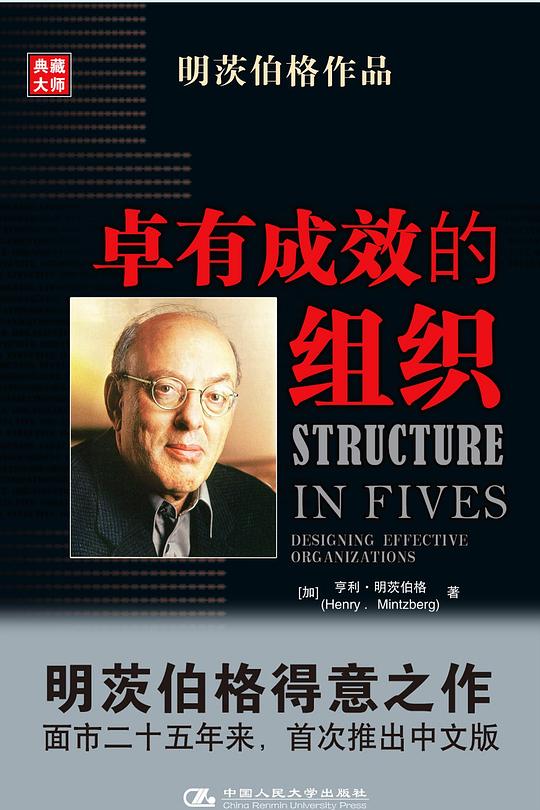
五种结构:设计有效的组织——卓有成效的组织之道
书名:卓有成效的组织
1
0

飞天小女警 2023-05-17 14:59:22
The English book title "Structure in Fives: Designing Effective Organizations" can be translated as "五种结构:设计有效的组织". "The Effective Organization" does not score well in relation to this book. First published in 1982, it has a recommended rating of 5 stars. The author, Henry Mintzberg, is a famous Western management expert and organizational theory specialist. This book is one of Mintzbergs representative works and is also his favorite one.
There are three parts to the book. The first part describes the 5 components of an organization. The second part explores the 5 coordination mechanisms necessary for a successful organization. The third part discusses the 5 basic organizational structures or modes of configuration.
The first structure discussed is the Simple Structure. It is characterized by simplicity and turbulence, with no hierarchy or divisions. All organizational matters are dealt with by the boss alone. Communication is smooth, with close member relationships.
The second structure is the Bureaucratic Structure. It is efficient and structured, with power delegated to managers. Rules, regulations, and standardization are used. Once formed, this structure is difficult to change or adjust. There are two forms of bureaucratic structures: the Mechanical Bureaucratic Organization and the Professional Bureaucratic Structure.
The third structure is the Professional Bureaucratic Structure. It is complex and stable, requiring formal training and expertise. Knowledge and technology are specialized. It promotes "elite democracy" and is commonly seen in universities, hospitals, and legal firms.
The fourth structure is the Divisional Structure, which is an intermediate structure. It is divided according to product lines or geographic regions, allowing each division to operate independently. The key design parameter for this structure is the standardization of work output.
The fifth and final structure is the Adhocracy Structure. This structure has multiple dispersed nodes and operates like a flexible, adaptive organization. It is suitable for complex innovative organizational needs. It is highly organic, with low levels of behavior standardization. Projects are usually managed in this way.
In the fourth part of the book, there are five theories on how organizations operate. The importance of organizational structure in the five modes of configuration is also discussed, including the fact that no organization perfectly fits into one of the five modes.
In summary, the five structures discussed in this book provide a basic criterion and framework for selecting and analyzing organizational structures in relation to the organizations environment and characteristics. It is a universal organizational model with great reference value for OD practitioners.
相关推荐
萤火谷的梦想家
艾莉森•麦吉出生于1960年,是美国《纽约时报》畅销书作家,同时也是大都会州立大学创意写作课的教授。她的作品被翻译成20多种语言并出版,也曾被提名普利策奖,并获得苏斯博士奖金奖、克里斯托弗图书奖、美国 [美]艾莉森•麦吉/[美]克里斯托弗•丹尼斯/绘 2023-03-27 16:50:25鬼马女神捕1·绝密卧底(上)
腹黑凤凰vs毒舌鸡妖——蓝翎:“小姬,跟我去人界吧!”姬十四:“干吗?让人宰了我做小鸡炖蘑菇吗?”蓝翎:“不啊,让妖怪宰了你做小鸡炖蘑菇更气派。”凤凰蓝翎和鸡妖姬十四生活在无忧无虑的灵界。他们的故乡叫 郝天晓 2023-04-17 00:22:47© 2023-2025 百科书库. All Rights Reserved.












发表评价